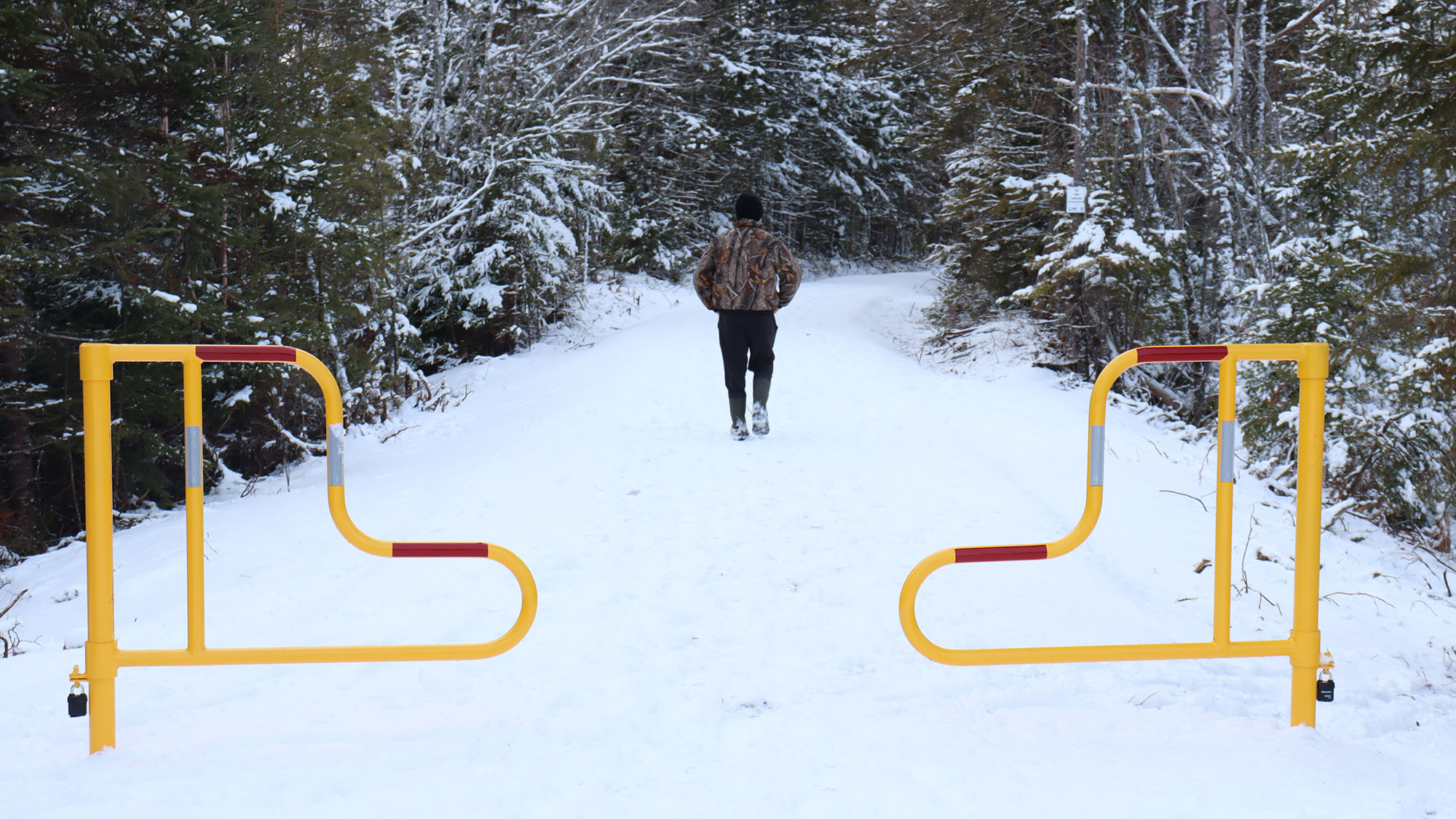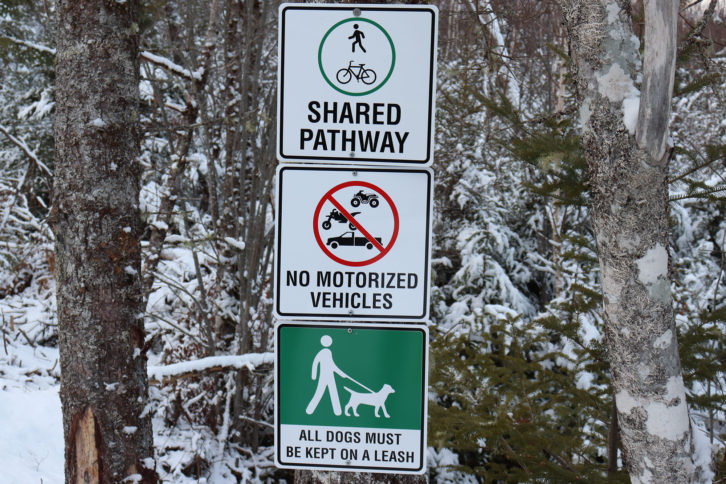Rural HRM communities in dispute over Gaetz Brook trail use
Active transportation association has restricted motorized vehicles on trail connector

caption
These barriers at the beginning of the trail are meant to prevent motorized vehicles from using it.The Eastern Shore communities of Musquodoboit Harbour and Porters Lake have hit a crossroad when it comes to the use of local trails, with disagreements coming to the attention of many in the community over the last year.
The disputes stem from one association not allowing motorized vehicles on the trails, and another community association demanding the trails be shared with everyone.
“We would like to see Nova Scotia be more inclusive and be on par with the rest of the Atlantic provinces for multi-use trails,” said Peter Debellefeuille, the president of the Nova Scotia Share Our Trails Association (NSSOTA).
He said he felt most people were not made aware of a proposal for non-motorized vehicle trails. Related stories
NSSOTA is an organization that believes that all trails should be shared among walkers, cyclists, horse riders and motorized vehicles.
Debellefeuille said Atlantic provinces, including New Brunswick, use multi-use trails as a form of tourism in their rural communities. He said this could be achievable because people would travel to rural Nova Scotia to use their all terrain vehicles (ATVs) along the trails and visitors could stay and dine at motels and inns in the smaller communities.
Mark Power, NSSOTA’s vice-president, said there are more than 3,000 members on their Facebook page. He admitted that he does not use the trails often, but cares deeply about the issue.
“The community is being destroyed, neighbours are arguing, this is what bugs me the most,” he said.
In December, Lands and Forestry Minister Iain Rankin gave authority over the Gaetz Brook connector trail from the province to the Shore Active Transportation Association Trails (SATA). The group also received permission to restrict motorized vehicles from the trail.
In response to these changes, Coun. David Hendsbee, municipal representative for the area, asked Rankin to overturn the Letter of Restriction, although Rankin rejected the proposal.
SATA Trails is an organization that aims to create more greenways for active transportation in Porters Lake and surrounding communities. Active transportation means transport by walking, cycling, snowshoeing, cross-country skiing and more.
Patricia Richards, co-chairperson of SATA Trails, said the group is focusing on its goal of promoting active transportation.
“It has nothing to do with whether or not we like motorized vehicles or not because we all have cars, but that’s not what we’re talking about,” she said in an interview.
In 2014, HRM’s transportation committee released a report on its active transportation plans between 2014 to 2019. The report mentions the Eastern Shore area, and Richards said SATA Trails is fulfilling HRM’s vision by making greenways.
She said the reason the trails in dispute are non-motorized is because the government will not fund shared trails. The Gaetz Brook Greenway received $890,626 from HRM and the province, and $254,714 from non-governmental organizations in 2019.
“We haven’t seen any good models or policies from anyone for a particular common ground,” she said. “We aren’t suggesting it can’t be done, but I don’t how it can happen right now.”
Debellefeuille said the many alternatives the association suggested to the government and SATA Trails were denied.
“There are many trails on old rail beds that are multi-use, all we’re asking is that ours be treated the same,” he said.
There are three other shared trails in HRM: the Blueberry Run in Seaforth, Shearwater Flyer and St. Margarets Bay.
Hendsbee said he has been a longtime advocate for shared trails. He pointed to the fact that the Gaetz Brook trail path is nine feet wide.
“There’s more than enough room to cut out a parallel trail for ATVs and snowmobiles and all they got to do is just share the bridges, causeways and road crossings,” said Hendsbee. “It would allow for shared trails. In my opinion this would solve the whole issue.”
Hendsbee said motorized vehicles should be allowed on the trails because the riders help to upkeep the trails.
“The active transportation groups are more dependent on the contractors to do the work and municipal maintenance, whereas motorized vehicle groups do a lot more volunteer labour,” he said.
Hendsbee said motorized vehicle owners use the trails for access so they can get to the back of the woods, whereas people who use it for active transportation do it for exercise and adventure.
“Shared trails have to be accommodating. There is trail etiquette. If you’re on a motorized vehicle, you have to stop and let the walkers, cyclists or horses go by,” he said.
“I do not see any changes to happen soon,” said Hendsbee. “In my opinion, there would have to be a change in government for there to be a change of opinion.”

caption
NSSOTA demands that trails be shared.The ATV Association of Nova Scotia (ATVANS) manages 1,100 kilometres of trail under a land use agreement with the Crown and private landowners. The Gaetz Brook corridor and Musquodoboit Harbour trail are not managed by ATVANS.
Barry Barnet, ATVANS executive director, said the organization doesn’t plan on jumping into the dispute. ATVANS allows its clubs to dictate whether or not they should get involved.
The club in the Musquodoboit Harbour and Porters Lake area did not have members who were ready to pursue the management of the trail, hence SATA Trails taking the position.
“It rests with the province of Nova Scotia to determine this. The locals that were concerned about it, they sought our advice but they didn’t take it,” said Barnet, adding that all of the trails managed by ATVANS are multi-use.
“We believe it’s better to include everybody. That way, we’re all responsible for looking after the trail,” he said.
NSSOTA continues to try and find common ground with SATA Trails.
“We’re not going to let this die. We’re going to continue fighting for our communities,” Power said.
About the author
Lesli Tathum
Lesli is from the Cayman Islands. She is in her fourth year of journalism at the University of King's College and is a member of the King's Women's...

R
Robert Siteman
D
David Hendsbee